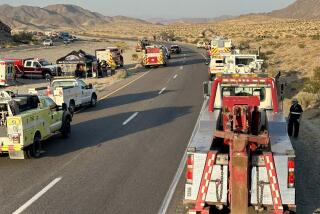Motorists criticize weather-related closure of the 5 Freeway in the Grapevine
- Share via
Should the Grapevine have been closed for nearly 24 hours because of a snowstorm?
That was a question some motorists stranded by the closure of California’s main north-south artery were asking Monday. The storm brought inches — rather than feet — of snow to Interstate 5. Several motorists noted that the scene seemed tame compared to last month’s blizzard that snowed under streets in New York and the Northeast.
“In other parts of the country, this is nothing,” said Todd Anderson, who was delayed on his way home to Shaver Lake and spent Sunday night at a roadside inn in Castaic. “I know if they would just let me up, I could make it through easy.”
But the California Highway Patrol on Tuesday strongly defended its decision to cut traffic off, saying that the icy road surface, steep grade of the Tejon Pass and heavy post-holiday traffic volume made the Grapevine simply too dangerous to navigate.
“It’s not a decision we like to make,” CHP Officer Patrick Etchebarne said. “The thinking is let’s close it now before it gets really, really bad. If you don’t, you’re going to have a nightmare.”
Etchebarne said that closures on the Grapevine and other mountain roads are designed to prevent a worst-case scenario, and that they generally are based more on road conditions than the experience level of individual drivers.
Most vehicles can traverse the steep inclines even in snowy conditions if they maintain a steady speed, he said. However, if an accident forces traffic to slow or come to a complete stop, and snow continues to fall, hundreds of vehicles can become stalled at once. The Tejon Pass is particularly vulnerable because of its steep hills and the number of big-rigs that travel on it, Etchebarne said.
In December 2008, the CHP waited too long to close the interstate and faced that exact scenario, Etchebarne said. Hundreds of drivers had to be rescued after their cars became stranded, and the American Red Cross was called to the scene.
“We’ve all been there before, and that’s what we don’t want,” he said.
The highway patrol and the California Department of Transportation, working from both the Fort Tejon Station in Lebec and the Newhall Station in Valencia, began monitoring the Grapevine about 11 a.m. Sunday when the area was first hit by a snowstorm, Etchebarne said. Officers escorted drivers along the pass, and waited for tow trucks to remove vehicles that had stalled, he said. Snow covered about 30 miles of the road, and visibility was poor.
About noon, as the snowfall was growing heavier, they realized that it was likely to continue falling throughout the day.
By 12:35 p.m., the road was officially closed, Etchebarne said.
“The timing was perfect,” he said.
Etchebarne attributed the length of the closure to the severity of the storm. He said that Caltrans worked through the night to clear the highway, but that it would have been impossible to open the road in the middle of the night because of the continuous snowfall.
The corridor received between 5 and 8 inches of snow during the storm, said Todd Hall, a meteorologist with the National Weather Service. He said wind speeds were measured at up to 35 mph, although one of the agency’s sensors was disabled during the storm.
Caltrans deployed trucks to apply a non-corrosive chemical that is used to melt ice, along with sand to improve traction, spokesman Patrick Chandler said.
From the edges of the closure — which stretched from the Kern County line to Castaic — drivers waited throughout the morning. Some said they were frustrated with the duration of the closure and wondered if it would have even been necessary in other regions of the country, where drivers are used to the snow.
The decision to keep the freeway closed Monday morning was based primarily on when the ice on the road had softened to the point that car tires would be able to break it up, said Sgt. Rick Miler of the CHP Newhall station.
“If there’s a possibility that people are going to slide, we can’t let them on,” said Caltrans’ Chandler.
The road was reopened about 11:30 a.m. Monday.
The CHP used an escort system both to ensure the safety of drivers and to make sure that the ice had cleared. At each end of the road, a single patrol car led about 1,000 vehicles at a speed of 35 mph. Etchebarne said. After each escort, officers checked ice conditions.
Four different escorts were required before the road could be opened at full speed, Etchebarne said.
He said it was “one of the best-run” road closures he had worked on in his years with the CHP.
More to Read
Sign up for Essential California
The most important California stories and recommendations in your inbox every morning.
You may occasionally receive promotional content from the Los Angeles Times.













